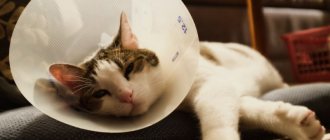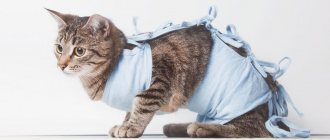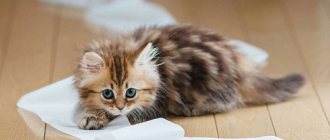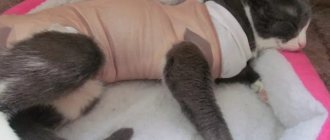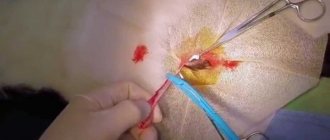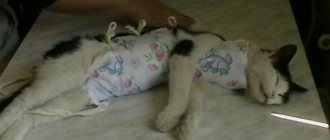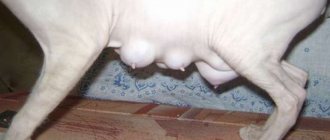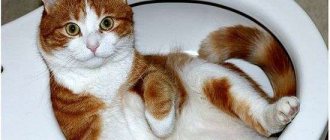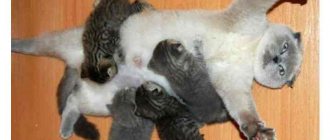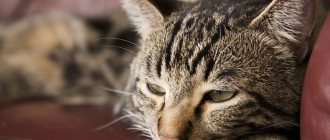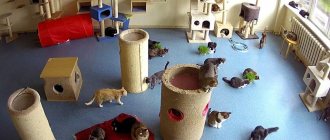Almost every cat owner once faces the question of castration of their pet. It is believed that castration has both positive and negative sides. The cat castration operation itself is not complicated. This is the removal of an animal's gonads through surgery.
Positive aspects of castration of cats:
- The animal's character improves. The cat will become more affectionate, calm and obedient.
- The animal will no longer mark its territory with secretions, leaving an unpleasant odor.
- Aggressive behavior and loud screams at night during “partying” will stop.
- Suppressed sexual instincts will not force the cat to look for a partner and rush outside. He will become a quiet pet.
- The risk of contracting a sexually transmitted infection is practically eliminated, and interest in cats disappears.
- Neutered cats live longer, about 3-4 years, as they lead a calmer home life.
All this has a positive effect on both the animal itself and the owner.
Possible negative points:
- After surgery, the cat begins to eat with a vengeance due to hormonal changes. Becomes less mobile and lazy. All this leads to pet obesity. These troubles can be solved by proper feeding and increasing the activity of the animal.
- After surgery, adult cats may still have problems walking and singing. Since in adult (mature) cats, not only the testes, but also the pituitary gland are responsible for the production of hormones. The castration operation may become useless. But it will help solve the problem of tag smell.
- There may be problems in the functioning of the cardiovascular system immediately after the operation. This is due to the use of anesthesia. This is more common in adult and older cats.
Veterinarians recommend castrating your pet before puberty, i.e. after eight months of age. Before surgery, it is mandatory to examine the animal to identify possible contraindications in order to exclude complications after surgery. Usually the operation lasts about half an hour.
After castration surgery, any complications are extremely rare. The doctor will listen to the cat's heartbeat and make sure that he is recovering from anesthesia. Caring for an animal after surgery is not difficult, the main thing is to follow the recommended diet, care for and love the animal.
We pick up the cat from the clinic
Most clinics, when castrating an animal, give its owner a memo that briefly outlines all his further actions. In some cases, the doctor verbally recounts all the points that the cat owner must complete.
Immediately after the operation, the pet remains in the clinic for some time to recover a little. This takes approximately half an hour - during this time you should make sure that the cat is not bleeding and the operation was completed successfully. If desired, the cat can be left in the hospital (in those clinics that provide this option) until it is restored, but few people can afford such a solution.
The length of a cat’s stay in the clinic depends on its health condition and the owner’s financial capabilities.
However, if the cat has a number of pathologies that make recovery difficult, such a solution is simply necessary, because if complications arise, you may simply not have time to take the animal to the doctor.
Shipping
To avoid unforeseen situations, the cat should be placed in a special carrier. The best option would be a plastic box, since it is the most spacious and provides excellent air circulation, unlike stuffy fabric options. Boxing will also provide freedom of movement that the cat will perform in a semi-conscious state.
Cover the bottom of the plastic box with a blanket or other cloth to prevent your pet from hypothermia.
It is advisable to take a blanket or heating pad with you to provide your cat with them. After anesthesia, the animal’s body temperature will drop, so it is logical to assume that it will be cold. This measure is especially important for cats with short hair or hairless cats.
Important! You should not place a heating pad under the wound itself, since the heat source will only provoke bleeding, impairing blood clotting.
Please note that the heating pad may move during movement.
During transportation, make sure that the animal does not change its position. Lay him on his side so that when he vomits, the pet does not choke on the contents of the stomach. Vomiting is uncommon, but may be the result of an individual reaction to the drug used for euthanasia. In addition, lying on its side will make it easier for the cat to breathe.
Transport
It is not recommended to transport your pet on public transport. Extraneous noises, loud sounds and unfamiliar smells will disturb the animal and cause it anxiety. To minimize your pet's discomfort, it is advisable to use a car or taxi as a means of transport. This way you will get there without unnecessary incidents and save yourself more nerves.
Never allow your cat to move freely around the car.
Do cats need any medications after sterilization?
In our clinic, sterilization surgery is carried out in a special operating room, in compliance with all medical rules of asepsis and antisepsis. Therefore, for healthy animals after planned sterilization, the use of antibiotics and other antibacterial drugs is not required; only local treatment of the postoperative suture is sufficient.
A veterinary surgeon can prescribe a course of antibiotics after surgery only if, during routine sterilization, it is discovered that the cat’s uterus is pathologically altered and inflamed. Provided that the cat is fed a balanced diet of ready-made food, additional vitamin supplements and other supporting agents are not required for the cat.
Further rehabilitation
The effects of anesthesia are clearly felt by the owner over the next 10-16 hours. Cats experience awakening from anesthesia individually, so it is impossible to say exactly when the animal will finally come to its senses. It is necessary to maintain control even after a few days, since residual effects after anesthesia, such as loss of coordination or dizziness, will make themselves felt.
Even though your pet's condition improves, remain vigilant and don't lose sight of him.
Some cats are overexcited during recovery. They rush around the apartment, meow loudly and climb on everything they can. You can't take your eyes off such individuals. Other animals tend to hide in a quiet, dark corner and wait out their unstable state there. Don't bother them again and let them be alone with themselves.
Feeding
The cat should be fed twelve hours after the end of the operation. Earlier meals are more likely to lead to vomiting, since the stomach has not yet had time to establish its functioning and cannot cope with the food that has entered it. When placing a bowl in front of the animal, do not insist on eating food under any circumstances. The pet will be able to independently understand its body and satisfy hunger when necessary. He is not in danger of starvation.
Meat broth will allow your cat to satisfy his hunger and avoid indigestion.
The diet for the rehabilitation period should be light, not overloading the digestion. The following should be completely excluded from it:
- dry food;
- canned food;
- meat;
- fish;
- porridge or cereals;
- vegetables.
While your cat is recovering, you need to forget about his usual diet.
In a word, everything that your pet willingly ate before surgery is subject to temporary withdrawal. You should stop at liquid types of food - broth or fermented milk products (provided the cat does not have lactase intolerance). Feed diluted with water should be gradually introduced into the diet.
Use of painkillers
There is no consensus among veterinarians on such an important point. Some experts claim that the animal is able to cope with the wound on its own, without medicinal support. Other veterinarians argue that the animal, of course, will cope, but by refusing him pain relief, we are committing an inhumane act and only increasing his suffering.
Painkillers in the form of solutions are usually administered subcutaneously to the cat.
One way or another, the cat is really able to cope with castration in the absence of auxiliary drugs. It is up to the owner to make a decision about what is more important – refusal of medications or comfortable rehabilitation. Most doctors still advocate the need to use painkillers in the first two days after surgery.
When does a cat need pain relief?
The belief that if a cat does not actively express its suffering, then it does not exist at all, is deeply mistaken. Cats are secretive animals and do not want to share their unhealthy state even with their owner. Signs that your pet is in pain include:
- complete refusal of food;
- lying motionless on the stomach;
- the paws are tucked in, they are practically invisible;
- pupils dilated;
- when attempting contact, the pet shows aggression;
- intense gaze, focused on one point.
Cats do not like to demonstrate the states they are experiencing, hiding physical pain from others
Remember that not all human pain medications are suitable for cats. Before purchasing such a drug, you should carefully read the instructions of your veterinarian, who will advise you on the correct medication.
Types of painkillers for cats
Painkillers can be in the form of tablets or injections. Injections are more effective, however, not every owner can cope with them. Among other drugs, veterinarians prefer the options described below.
After castration, some pets require additional medication support
Table 1. Painkillers for cats
| A drug | Dosage | Description | A course of treatment |
| Ketofen | Tablets: 1 mg of the drug per 1 kg of animal weight Solution: administered at the rate of 0.2 ml of the substance per 1 kg of weight | An anti-inflammatory drug that effectively affects the source of pain. Available in the form of tablets and solution. Injections are given only subcutaneously. It should not be taken over a long course due to a wide range of side effects, since the medication is designed for five days of use. | From 2 to 5 days depending on the condition of the animal |
Ainil | Solution: 0.2 ml per 1 kg of animal weight | A one percent solution, available in ampoules, which relieves your pet of pain. Shake the bottle before using the drug. Cats are administered only subcutaneously. The drug does not accumulate in the body and is soon excreted in the urine | from 1 to 3 days |
Previcox | One tablet per 3 kg of weight | A universal pain reliever suitable for both cats and dogs. Available in tablet form. Due to the pleasant aroma, cats easily eat the drug | The tablet is given once a day for 3 days |
Painkillers usually act within twelve hours, after which their effectiveness decreases. All these drugs are not designed for pain caused by the healing of an open wound, therefore, if necessary, it is allowed to use the above drugs twice as often, but only for the first two days. Excessive consumption of painkillers will lead to intoxication of the body of an already weakened animal.
Painkillers have an aggressive effect on the body, so their use should be limited
Are painkillers always required?
An owner should not give pills to a cat simply because he has learned that the pet may experience pain. All animals have different pain thresholds, and there are animals that recover extremely quickly after surgery. Breeds that successfully cope with castration include Persian and British cats.
Persian cats tolerate castration more easily due to their body characteristics
For the rest, you should focus on the current state of the cat and act in accordance with it. If attacks of pain do not go away after two designated days, you should immediately contact a veterinarian. If the animal quickly regains consciousness and looks healthy, there is no point in pumping it with medications.
How many hours after castration can you feed a cat?
The cat has bleeding on the second day after giving birth
It is not recommended to feed the cat for 24 hours after surgery, since the weakened body will not cope with the digestive process, causing vomiting and its entry into the upper respiratory tract. You can drink a small amount of water no earlier than 4-6 hours after your pet wakes up. It is important to ensure that the sick cat has free access to clean water, since after anesthesia he will be very thirsty.
After anesthesia, your pet will be very thirsty
Tray
It is natural to assume that a cat that has survived castration will find it very difficult to use the litter box at first. The need to climb into it and stretch the wound will cause attacks of pain and negative associations. You should not be angry with your pet if, after surgery, he empties his intestines and bladder in the wrong place for some time. In addition to the pain experienced, the cat may simply have poor orientation in space when recovering from anesthesia.
During recovery, the cat may temporarily refuse the tray due to inconvenience during use.
In addition, if you use natural crumbly litter for the tray, there is a high probability of dust and small particles getting into the cut areas of the skin, which can result in inflammation. Therefore, while the wound is healing, it is advisable to have as an alternative a tray with a grid that will not allow the pet to come into contact with the filler.
Urination
Infrequent emptying of the bladder after castration is completely natural. First, your pet has barely consumed any fluids or food in the past few hours. Secondly, urination is still a painful procedure for the animal, so it is in no hurry to do it.
Difficulty urinating should not bother owners in the first couple of days
Don't panic if you see traces of blood in your pet's urine. Drops of blood may leak from a healing wound. The urge returns gradually, and after a few days the cat usually returns to its natural state and uses the litter box without problems.
Loud meowing during urination and unsuccessful trips to the toilet should be a cause for concern and take the animal to the veterinarian.
If you wish, to avoid puddles throughout the house, you can try to dress your pet in diapers. However, cats do not always support this decision and resist. You can read below about how to choose a suitable diaper and put it on your cat.
Diapers for cats: application and cost
Why is surgery needed?
Surgery is used to suppress and eliminate sexual instincts. After it, the animal ceases to be interested in the other sex and mark its territory.
General information
Castration is carried out under anesthesia. During the operation, the surgeon makes an incision in the scrotum, removes the testes from it and tightens the spermatic cords. Upon completion, a suture is placed on the wound or simply treated with an antiseptic.
The operation reduces the likelihood of oncology and inflammation of the prostate. Thanks to the stabilization of hormonal levels, the average life expectancy of a castrated cat increases by 3-4 years.
Optimal age of the animal
Veterinarians recommend castrating animals at 7-9 months, that is, after puberty. Exceptions are allowed only for kittens of large breeds weighing more than 3 kg (they are operated on later) and for animals of different sexes from the same litter living together. In the latter case, pets mature faster than their peers, so there is no risk of continued underdevelopment of the urethra and penis.
Treatment of the wound
The surgeon deals with a wound resulting from an operation in two possible ways:
- Places stitches. This method is less common these days and is used for cats that have problems with blood clotting.
- Treats the wound with brilliant green and lets it heal on its own.
Accordingly, care for the resulting wound depends on the method of its healing. If there are seams, it is recommended to treat them twice a day with hydrogen peroxide and re-lubricate them with brilliant green. Most modern veterinary clinics use absorbable sutures that do not require their removal.
In most cases, re-treatment of a healing wound with green is not required.
Wounds that remain open do not require self-care unless there are obvious signs of complications. The only difficulty that the owner may encounter is the animal’s excessive attention to its wound. Licking an unprotected area of flesh is undesirable and risks introducing infections. That’s why special collars are put on overly active pets.
Prevent bleeding
Blood and ichor may leak out for several days after surgery. Blood can either concentrate in the scrotum area or flow down the hind limbs. To prevent excessive bleeding, it is permissible to use Dicinone, which improves blood clotting.
Dicinone helps reduce bleeding
The drug is available in the form of tablets and solutions - in our case, it is the solution that is needed. Injections are given intramuscularly, 0.1 ml of the substance per 1 kg of pet’s weight. The optimal place for the injection is the thigh. In addition to injections, it is recommended to apply an ice pack to the wound for ten minutes, four times a day.
If bleeding is accompanied by increased weakness, fainting and bluish mucous membranes, you should immediately contact a veterinarian.
Possible complications after castration
Recovery after surgery occurs individually for all individuals, but it is important to sense in time the line between normal and a dangerous condition that requires intervention. Based on the time of manifestation of complications, they are divided into two types.
- Early - they appear even before you have time to leave the clinic with the animal. Sometimes the first signs of problems make themselves felt on the operating table. Most often, such complications include bleeding and prolapse of the organs closest to the incision (testes, omentum, etc.). This is why post-operative recovery is important to allow the pet’s health to stabilize;
Early complications make themselves felt within the clinic and are quickly eliminated by a specialist
- Late ones - they make themselves felt after the cat is at home and begins to come to his senses. As a rule, late complications are associated with the penetration of pathogenic microbes into the healing wound, causing inflammatory processes. Poorly washed scrotum before the operation, unhygienic instruments, violation of the rules for transporting the animal - all this can cause further health problems.
Late complications should be diagnosed by the owner himself to avoid deterioration of the pet’s health.
It is possible to identify the presence of an infection in a cat’s body without a thorough study of its anatomy. Of course, when a section of the intestine prolapses, the diagnosis is obvious, but there are also less obvious, but no less dangerous options. It is enough to note a few main symptoms:
- body temperature rises by 1.5-2 degrees;
- stiff gait resulting from discomfort in the perineal area;
- lack of appetite and lethargy for several days;
- tense abdomen, painful on palpation;
A painful abdomen indicates possible inflammation that occurred after surgery.
- difficulty urinating;
- purulent discharge from the wound;
- shortness of breath, rapid heartbeat.
If the above signs are present, it is necessary to contact the doctor who performed the operation and describe in detail the animal’s condition in order to develop further actions.
When is it time to sound the alarm?
We found that a slight decrease in temperature after surgery is quite normal. But you can measure not only a reduced value, but also an increased value! Alas, a significant (more than one degree) increase in a cat’s body temperature that lasts for more than six hours is not a normal indicator at all. In this case, it would be a good idea to call your veterinarian. Most likely, a pronounced inflammatory process has begun in your pet’s body. Bacterial contamination of the operated area occurred.
